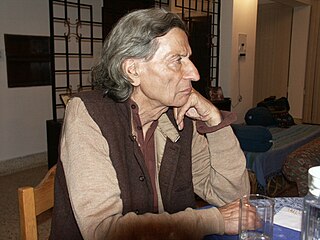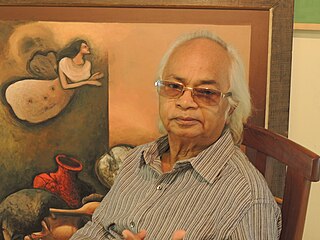
Ghulam Mohammed Sheikh is a painter, poet and art critic from Gujarat, India. He was awarded the Padma Shri in 1983 and Padmabhushan in 2014 for his contribution in field of art.

Ram Kumar was an Indian artist and writer who has been described as one of India's foremost abstract painters. He was associated with the Progressive artists' group along with greats like M.F. Hussain, Tyeb Mehta, S.H. Raza. He is said to be one of the first Indian artists to give up figurativism for abstract art. His art commands high prices in the domestic and international market. His work "The Vagabond" fetched $1.1 million at Christie's, setting another world record for the artist. He is also one of the few Indian Modernist masters accomplished in writing as well as painting.

Sayed Haider Raza was an Indian painter who lived and worked in France for most of his career. Born on 22 February 1922 in Kakkaiya, Central Provinces, British India, Raza moved to France in 1950, marrying the French artist Janine Mongillat in 1959. Following her death from cancer in 2002, Raza returned to India in 2010, where he would live until his death on 28 July 2016.

Shree Lal Joshi was an Indian Chippa caste artist of phad painting, a form of popular folk painting of Rajasthan.

Blue pottery is widely recognized as a traditional craft of Jaipur of Central Asian origin. The name 'blue pottery' comes from the eye-catching cobalt blue dye used to colour the pottery. It is one of many Eurasian types of blue and white pottery, and related in the shapes and decoration to Islamic pottery and, more distantly, Chinese pottery.
Ram Gopal Vijayvargiya (1905–2003) was an Indian painter. He was also a poet and a writer.

Keshav Malik was an Indian poet, art and literary critic, arts scholar, and curator. He remained art critic for the Hindustan Times (1960–1972) and The Times of India (1975–2000). He published eighteen volumes of poetry and edited six anthologies of English translations of Indian poetry.

Bikash Bhattacharjee was an Indian painter from Kolkata in West Bengal. Through his paintings, he depicted the life of the average middle-class Bengali – their aspirations, superstitions, hypocrisy and corruption, and even the violence that is endemic to Kolkata. He worked in oils, acrylics, water-colours, conté and collage. In 2003, he was awarded the highest award of Lalit Kala Akademi, India's National Academy of Arts, the Lalit Kala Akademi Fellowship.
Jyotindra Manshankar Bhatt, better known as Jyoti Bhatt, is an Indian artist best known for his modernist work in painting and printmaking and also his photographic documentation of rural Indian culture. He studied painting under N. S. Bendre and K.G. Subramanyan at the Faculty of Fine Arts, Maharaja Sayajirao University (M.S.U.), Baroda. Later he studied fresco and mural painting at Banasthali Vidyapith in Rajasthan, and in the early 1960s went on to study at the Academia di Belle Arti in Naples, Italy, as well the Pratt Institute in New York. He was awarded the Padma Shri in 2019 and elected as a Fellow of the Lalit Kala Akademi in 2022.
Haku Vajubhai Shah was an Indian painter, Gandhian, cultural anthropologist and author on folk and tribal art and culture. His art belonged to the Baroda Group and his works are considered in the line of artists who brought themes of folk or tribal art to Indian art.

Ramkishan Adig is an Indian artist and a practitioner of The Social-Realism style in painting. Born of a small village in Rajasthan (India), he studied art at Rajasthan school of Art, Jaipur. He joined the Progressive Writers Association and Peoples' Theater Association as an executive. He has participated many national and international level exhibitions, and his work is centered on themes based in Rajasthani culture. He is currently a Art faculty for Navodaya Vidyalaya Samiti

Padma Bhushan Amar Nath Sehgal was a noted Indian modernist sculptor, painter, poet and art educator. He started his career as an engineer in Lahore, and later turned to art. He shifted to Delhi after partition of India in 1947, and in 1950 studied art education from New York University School of Education. Subsequently, became an art educator, teaching at College of Art, Delhi, and at the Modern School Barakhamba, New Delhi. However, he also ventured into painting, drawings, and poetry.
Syed Shakir Ali, is an Indian painter, known for his Mughal and Persian miniature paintings. He was honoured by the Government of India, in 2013, by bestowing on him the Padma Shri, the fourth highest civilian award, for his contributions to the field of art.
Shanti Dave is an Indian painter and sculptor, considered by many as one of the major Indian artists of the twentieth century. He is a former member of the Lalit Kala Akademi and the Sahitya Kala Parishad. The Government of India awarded him the fourth highest Indian civilian honour of Padma Shri in 1985.
Manu Parekh is an Indian painter, known for his several paintings on the city of Varanasi. Reported to be influenced by Rabindranath Tagore and Ram Kinker Baij, Parekh is a recipient of the 1982 Lalit Kala Akademi Award. The Government of India awarded him the fourth highest civilian award of the Padma Shri, in 1991.
Ranbir Singh Bisht (1928–1998) was an Indian painter and the Principal of the College of Fine Arts, Lucknow University. Born in 1928 at Landsdowne in Garhwal, in the present day Indian state of Uttarakhand, he secured Drawing Teacher's Training Certificate and Diploma in Fine Arts from the Government College of Art and Craft, Lucknow. He conducted many solo shows in a number of Indian cities besides a show in New York and participated in group shows in Frankfurt and Tokyo. He was also a participant of the 4th Triennale at New Delhi in 1972.
Biren De (1926–2011) was an Indian painter of modern art, known for his paintings with tantric influences. His paintings were characterized by symmetrical patterns of geometry and the presence of tantric symbols such as mandala, phallus and vagina, reportedly representing masculine and feminine energies of the universe. The Government of India awarded him the fourth highest civilian honour of the Padma Shri in 1992.

Surendra pal Joshi was an Indian artist known for his use of experimental techniques in paintings, sculptures and murals. His works are in the collection of Uttara Museum of Contemporary Art in Dehradun, India.

Jagadish Chandra Dey, also known as Jagdish Dey, is an Indian painter and printmaker, known for his unique style of surrealism, where the real and unreal coexist. He has been a member of many art societies and juries.










